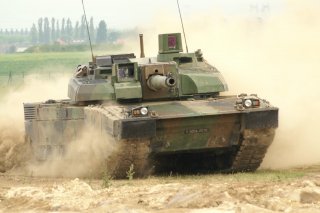Cold War History: The Soviet Union Had a Plan To Conquer France
It would have only taken one week.
Here's What You Need to Know: The Soviet plan was nearly as ambitious as previous Nazi plans.
The Nazis conquered France in six weeks, in one of the most spectacular military victories in history.
Had the Soviet Union gone to war with the West in the early 1960s, it also planned to blitz France. But unlike the Germans, the Soviets planned to do it in a week, according to the Warsaw Pact's 1964 war plan, discovered in the military archives of the former Czechoslovakia.
Was this an example of military might or military megalomania? For a system that professed not to believe in God, the Soviet plan appears nothing short of miraculous. Put simply, all the Soviets and their Eastern European allies had to do was launch their offensive from Czechoslovakia, smash through southern Germany, cross the Rhine River, and then drive into southern France. All this to be accomplished in about seven days, or as long as God took to create the Earth. And even He needed to take a rest at the end.
The Soviet plan was nearly as ambitious. It called for the Czech First and Fourth Armies to push for the Franco-German border, while the Soviet Eighth Guards Army advanced on their northern flank and the Hungarians on their southern flank. Paratroopers would seize crossings over the Neckar and Rhine Rivers. The Warsaw Pact tanks and mechanized infantry were expected to thrust about 700 miles from Czechoslovakia to Besancon, about 150 miles northeast of Lyon, by D+8. From there, the Soviets could thrust north to Paris and the Channel ports, or south to the Mediterranean ports such as Marseilles.
To strike from Czechoslovakia to Besancon would require the Red Army to travel around 60 miles per day. To put this in perspective, one of the most rapid advances in history was made by Rommel's Afrika Korps in June 1942, when German mechanized units routed the British Eighth Army and advanced 350 miles in 10 days, or 35 miles per day. Even during the 1940 German blitz that devastated France, Rommel's famed 7th Panzer Division advanced only 85 miles in five days.
The obstacles were daunting. Despite the Western image of the Soviet steamroller, Moscow's planners were only counting on parity or perhaps a slight numerical superiority over NATO forces. The Soviets and Czechs would also have had to cross a battlefield of rivers, hills and towns. Possibly the NATO air forces would have been too busy in North and Central Germany to intervene in the south, but the Warsaw Pact would likely have lacked the air superiority and air support that the Germans enjoyed in 1940.
However, the Soviets were counting on a weapon that Rommel didn't have. The Red blitzkrieg would have been paved by a deluge of nuclear weapons from the start of the war. According to the war plan, "the operation will require the use of 131 nuclear missiles and nuclear bombs; specifically 96 missiles and 35 nuclear bombs. The first nuclear strike will use 41 missiles and nuclear bombs. The immediate task will require using 29 missiles and nuclear bombs. The subsequent task could use 49 missiles and nuclear bombs. 12 missiles and nuclear bombs should remain in the reserve of the Front."
Could it have worked? Certainly, if everything worked perfectly. That is, if the U.S. 7th Corps, West German 2nd Corps, and French First Army could not stop the Soviet advance, or at least delay it until reinforcements and reserves arrived. Or, if a landscape pitted with nuclear craters and frazzled by radiation from NATO as well as Soviet nuclear weapons didn't hamper Red troops and supply columns. Or, if all the thousand and one other frictions that plague every military plan never happened.
France had also detonated its first atomic bomb in 1960, and by 1964 the French Air Force was fielding nuclear-armed bombers. Perhaps the threat of Soviet nuclear retaliation would have deterred Paris from nuking Moscow. Then again, the thought of enduring another Occupation - this time Communist instead of Fascist - might have spurred a "Better Dead than Red" response.
Either way, Western Europe would have been nuclear rubble. Or as the French would say, "C'est magnifique, mais ce n'est pas la guerre: c'est de la folie." It's magnificent, but it isn't war.
Michael Peck is a contributing writer for the National Interest. He can be found on Twitter and Facebook.
This article first appeared several years ago.
Image: Reuters

